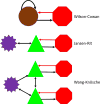Simulating laminar neuroimaging data for a visual delayed match-to-sample task
- PMID: 29476912
- PMCID: PMC5911248
- DOI: 10.1016/j.neuroimage.2018.02.037
Simulating laminar neuroimaging data for a visual delayed match-to-sample task
Abstract
Invasive electrophysiological and neuroanatomical studies in nonhuman mammalian experimental preparations have helped elucidate the lamina (layer) dependence of neural computations and interregional connections. Noninvasive functional neuroimaging can, in principle, resolve cortical laminae (layers), and thus provide insight into human neural computations and interregional connections. However human neuroimaging data are noisy and difficult to interpret; biologically realistic simulations can aid experimental interpretation by relating the neuroimaging data to simulated neural activity. We illustrate the potential of laminar neuroimaging by upgrading an existing large-scale, multiregion neural model that simulates a visual delayed match-to-sample (DMS) task. The new laminar-based neural unit incorporates spiny stellate, pyramidal, and inhibitory neural populations which are divided among supragranular, granular, and infragranular laminae (layers). We simulated neural activity which is translated into local field potential-like data used to simulate conventional and laminar fMRI activity. We implemented the laminar connectivity schemes proposed by Felleman and Van Essen (Cerebral Cortex, 1991) for interregional connections. The hemodynamic model that we employ is a modified version of one due to Heinzle et al. (Neuroimage, 2016) that incorporates the effects of draining veins. We show that the laminar version of the model replicates the findings of the existing model. The laminar model shows the finer structure in fMRI activity and functional connectivity. Laminar differences in the magnitude of neural activities are a prominent finding; these are also visible in the simulated fMRI. We illustrate differences between task and control conditions in the fMRI signal, and demonstrate differences in interregional laminar functional connectivity that reflect the underlying connectivity scheme. These results indicate that multi-layer computational models can aid in interpreting layer-specific fMRI, and suggest that increased use of laminar fMRI could provide unique and fundamental insights to human neuroscience.
Keywords: Computational modeling; Cortical layers; High-resolution fMRI; Human; Laminar fMRI; Neural mass models.
Published by Elsevier Inc.
Figures



















Similar articles
-
Investigating the neural basis for fMRI-based functional connectivity in a blocked design: application to interregional correlations and psycho-physiological interactions.Magn Reson Imaging. 2008 Jun;26(5):583-93. doi: 10.1016/j.mri.2007.10.011. Epub 2008 Jan 10. Magn Reson Imaging. 2008. PMID: 18191524
-
Investigating the neural basis for functional and effective connectivity. Application to fMRI.Philos Trans R Soc Lond B Biol Sci. 2005 May 29;360(1457):1093-108. doi: 10.1098/rstb.2005.1647. Philos Trans R Soc Lond B Biol Sci. 2005. PMID: 16087450 Free PMC article.
-
Functional connectivity in fMRI: A modeling approach for estimation and for relating to local circuits.Neuroimage. 2007 Feb 1;34(3):1093-107. doi: 10.1016/j.neuroimage.2006.10.008. Epub 2006 Nov 28. Neuroimage. 2007. PMID: 17134917 Free PMC article.
-
Laminar fMRI and computational theories of brain function.Neuroimage. 2019 Aug 15;197:699-706. doi: 10.1016/j.neuroimage.2017.11.001. Epub 2017 Nov 2. Neuroimage. 2019. PMID: 29104148 Review.
-
Laminar fMRI: What can the time domain tell us?Neuroimage. 2019 Aug 15;197:761-771. doi: 10.1016/j.neuroimage.2017.07.040. Epub 2017 Jul 20. Neuroimage. 2019. PMID: 28736308 Free PMC article. Review.
Cited by
-
Evaluating the capabilities and challenges of layer-fMRI VASO at 3T.Apert Neuro. 2023;3:10.52294/001c.85117. doi: 10.52294/001c.85117. Epub 2023 Aug 9. Apert Neuro. 2023. PMID: 39991189 Free PMC article.
-
Quantifying Differences Between Passive and Task-Evoked Intrinsic Functional Connectivity in a Large-Scale Brain Simulation.Brain Connect. 2018 Dec;8(10):637-652. doi: 10.1089/brain.2018.0620. Brain Connect. 2018. PMID: 30430844 Free PMC article.
-
LayNii: A software suite for layer-fMRI.Neuroimage. 2021 Aug 15;237:118091. doi: 10.1016/j.neuroimage.2021.118091. Epub 2021 May 12. Neuroimage. 2021. PMID: 33991698 Free PMC article.
-
Leveraging ultra-high field (7T) MRI in psychiatric research.Neuropsychopharmacology. 2024 Nov;50(1):85-102. doi: 10.1038/s41386-024-01980-6. Epub 2024 Sep 9. Neuropsychopharmacology. 2024. PMID: 39251774 Review.
-
Layer-dependent activity in human prefrontal cortex during working memory.Nat Neurosci. 2019 Oct;22(10):1687-1695. doi: 10.1038/s41593-019-0487-z. Epub 2019 Sep 23. Nat Neurosci. 2019. PMID: 31551596 Free PMC article.
References
Publication types
MeSH terms
Grants and funding
LinkOut - more resources
Full Text Sources
Other Literature Sources

